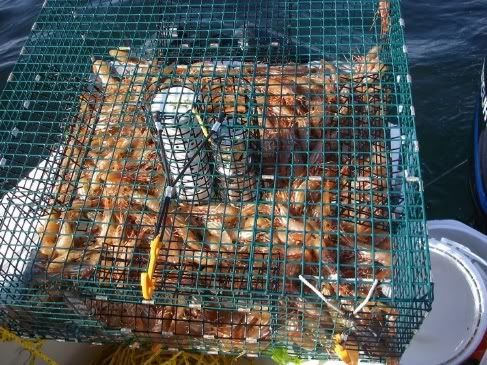Early in the morning, on Hood Canal, I was eating breakfast and noticed a lot of boat traffic. There seemed to be boats everywhere setting square traps with yellow buoys in the water. I asked my grandfather what was going on. He said they were shrimping. We asked the neighbor to show us his catch and he said he would in about an hour. Not knowing what to expect, he came over and showed us a platter of cooked spot shrimp. That was all it took for my grandparents and me. We had to try ourselves. That was in the eighties and I have been shrimping ever since.
Spot Shrimp ( Pandalus platyceros ) have a deep pink/red or pink/orange body with white lines on the head and paired spots on their back behind their head and just before the tail.

Puget Sound shrimp have a unique reproductive cycle, starting as males for one to two years, then changing sex to reproduce as females. Some will change to females at an earlier age, or even skip the male phase completely. This will help the supply of egg-producing females each year. Spawning in late summer or fall the female can produce as many as 6,000 eggs and carries them until early spring. Once hatched they are planktonic for up to three months, then settling on the sea floor.
Shrimping Gear:
Shrimp pots are available at most sporting goods stores, made of plastic dipped wire. To keep the cost down, many shrimpers choose to make their own with 7/8"mesh. If building your own pot’s consult the WDFW rules pamphlet for regulations on design, and mesh size. I use the
McKay shrimp pots with ramp
 entrances and also pots that have funnel entrances. The pots with the ramps seem to produce better. Weighting your pots is a must either with lead, zinc, or rebar. The rebar will create electrolysis and may discourage shrimp to enter. Dipping the rebar or sealing it will stop this.
entrances and also pots that have funnel entrances. The pots with the ramps seem to produce better. Weighting your pots is a must either with lead, zinc, or rebar. The rebar will create electrolysis and may discourage shrimp to enter. Dipping the rebar or sealing it will stop this.A yellow buoy is required with your name and address. I made my buoys with PVC pipe and two floats, with lead at the bottom to keep it straight up. I even put a custom flag on the top to distinguish them from others.
I equip each pot with 425 feet of 1/4"yellow poly rope or 5/16" on bigger pots to reach the bottom. I have marked every 100 feet. I have also marked the first 25' from the pot so I can see how much more to pull. With the poly line you will need lead weights to keep the extra line down. You can also get a leaded line but at a steeper price.
Most of the shrimpers today use pullers to assist in pulling up traps. Pulling can be done by hand, but this is not something I would want to do. Three to five horse power gasoline engines with a six to one reducer makes pulling 425' of rope an easy assignment. A 5-HP puller will pull 180 to190 feet per minute. Now on the market are electric trap pullers. An electric puller will draw from 32 to 54 amps under load and 90 to140 feet per minute depending on which motor you have. They are not fast but will quietly do the job.
Cat food is the most popular bait used by shrimpers. Fish flavored is a must! In Hood Canal the most popular brand is Puss n Boots. Other baits to consider are the commercial shrimp pellets, ground clams and oysters, fresh or frozen fish. Although with fish, you may attract starfish or crabs so I only use a small amount. The whole key is to have your bait leave a sent trail. Try not to use anything that has shrimp in it. They are not cannibalistic.
Shrimp can be found in depths more than 1000 feet but are generally caught at 40 to 350 feet. They tend to like rocky bottoms, rock crevices, vertical rock faces, and sponge beds.
I like to set my pots (depending where I am shrimping) in 190 to 325 feet of water. While lowering the pot I wait till the rope goes slack then attach my line weight. Now that I have reached bottom I have to let out enough line so the current won’t sink my buoys. This is where having 425 feet comes in to play. In Hood Canal where I shrimp the current is lower so I will put out an extra 35 feet out. Puget Sound I will let out all of the 425 feet to avoid from losing any gear.
Finding where to shrimp is a big deal with shrimpers they won’t tell you anything! The best way to find out where to set your pots is know someone and go with them, or wait till you see people setting their pots and place yours around them.

Now that you have your shrimp caught what to do with them. Most people put them in a five-gallon bucket till they leave the water. I like to keep them in an aerated live well till I hit the docks. This keeps the shrimp alive and frisky. When they expire, the shrimp excrete a jelly substance, it’s good to rinse this off before cooking or freezing.
Other than the first initial start up costs shrimping is fun, easy, and a great family outing for all ages. What couldn’t be better than limits of fresh shrimp, friends, and family? Good luck! And be safe.

.gif)
.jpg)

